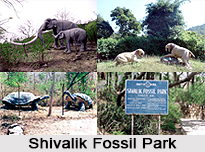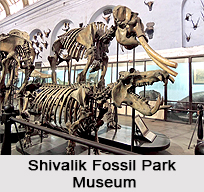 Shivalik Fossil Park is a fossil park situated at Suketi and is also known as the "Suketi Fossil Park". Shivalik Fossil Park is 14 km from Nahan, the district headquarters of Sirmaur, Himachal Pradesh. It is a fossil park with a collection of prehistoric vertebrate fossils and skeletons recovered from the upper and middle Shivaliks geological formations of sandstones and clay. The park has a display of the fossil finds and also an open air exhibition of 6 extinct mammals formed in life-size models made of fiberglass and resins, in a natural ambiance of the Shivalik Hills environment of the Plio-Pleistocene era from where the fossils were unearthed. There is also a museum, within the precincts of the park, where the fossils are curated and exhibited. It is Asia"s biggest fossil park. This park is really remarkable attraction of this state. This is the only park of Asia that has been established on the site where the fossils were found in actual. The exhibits in the park are used for generating scientific interest in the public and for facilitating special international studies by visiting research scholars from all over the world, apart from tourism development.
Shivalik Fossil Park is a fossil park situated at Suketi and is also known as the "Suketi Fossil Park". Shivalik Fossil Park is 14 km from Nahan, the district headquarters of Sirmaur, Himachal Pradesh. It is a fossil park with a collection of prehistoric vertebrate fossils and skeletons recovered from the upper and middle Shivaliks geological formations of sandstones and clay. The park has a display of the fossil finds and also an open air exhibition of 6 extinct mammals formed in life-size models made of fiberglass and resins, in a natural ambiance of the Shivalik Hills environment of the Plio-Pleistocene era from where the fossils were unearthed. There is also a museum, within the precincts of the park, where the fossils are curated and exhibited. It is Asia"s biggest fossil park. This park is really remarkable attraction of this state. This is the only park of Asia that has been established on the site where the fossils were found in actual. The exhibits in the park are used for generating scientific interest in the public and for facilitating special international studies by visiting research scholars from all over the world, apart from tourism development.
History of Shivalik Fossil Park
The idea to establish a museum was mooted to preserve the fossil site and the fossils from being indiscriminately extracted and vandalized. It was also intended to provide prehistoric period scientific information to scholars for research. The Geological Survey of India, in close association with the Government of Himachal Pradesh, took the initiative and established the park on 23 March 1974. The park is also maintained by the Geological Survey of India. The mammalian fossils found in the Shiwaliks of this park are one of the world`s richest antiquities.
 Features of Shivalik Fossil Park
Features of Shivalik Fossil Park
The fiberglass models on display in an open area in the fossil park are of 6 extinct animals. These are: Huge land Tortoise, Gharial, Four Horned Giraffe, Sabre-toothed Cat, large tusked Elephant and Hippopotamus.
Museum of Shivalik Fossil Park
Many stunning fossil variety is of vertebrates and have been exhibited in the park in a small museum. The exhibits in the museum have a plethora of skeletal remains of different groups of skulls and limbs of mammals, skulls of hippopotamuses, tortoises, gharials and crocodiles, tusks of 22 species of elephants, rocks and charts and paintings related to the several aspects of plants and animals life of the past and present. The stone items on display belong to the Early Palaeolithic Man. The museum also houses antiquities unearthed by "Captain Cautley" in the area, from which he dug out the remains of Asia"s oldest human ancestor. The country"s postage stamp to commemorate the centenary of the Geological Survey of India in 1951 is displayed as well. This stamp has a picture of two elephants with tusks.











